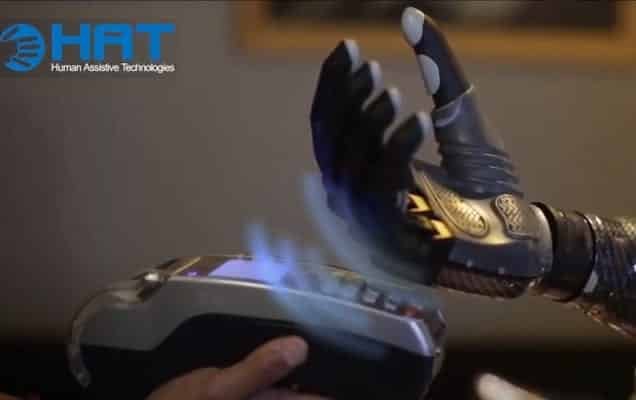Electronic skin will play a key role in achieving full sensory feedback from bionic limbs. Here is the current state of this technology.
The Miracle of Human Skin
Human skin is remarkable. It is mechanically tough, stretchable, and self-repairing. It plays a vital role in both temperature regulation and the immune system. And it has a sensory system capable of differentiating between thousands of sensations.
This short video elaborates on some of these unique capabilities:
Because our natural skin is so tightly integrated with many of our bodily functions (such as circulating 25 % of our blood supply at any one time), it is not practical at this stage to envision electronic skin performing all these functions. But it can play a vital role in connecting users of bionic limbs to the outside world.
Electronic Skin Requirements
Replacement Capabilities
The initial electronic skin requirements mostly involve duplicating the sensory capabilities of natural skin. Using bionic hands as an example, electronic skin needs to be able to detect:
- Contact and pressure. Users need to know when they’ve come into contact with an object and especially how much pressure they are applying when they grasp that object. This is currently being achieved in some bionic hands with the use of pressure sensors in bionic fingertips, but this is inadequate because the contact points on a hand can vary depending on the grip being used and the shape of the object.
- Slippage. A different form of contact where the skin must be able to detect the movement of an object across the skin’s surface.
- Texture, meaning the ability to identify different surfaces. For example, if you reach into a bowl of fruit without looking, can you tell that you’ve touched an apple (smooth) versus an orange (pitted)?

- Shape. You wake up in the dark and fumble around to turn on your nightlamp. How do you find the lamp and then the switch? You need to be able to feel the shape of an object to achieve this.
- Temperature. This might not be that important for avoiding damage to a bionic hand in a typical household setting, but it would be nice to know how hot something is before you pass it to someone else.
- Pain. This could be very important for avoiding damage to a hand.
Electronic skin also needs to be extremely stretchable and durable!
New Capabilities
As is the case with a lot of human bionic capabilities going forward, we also have to consider some potential enhancements. Here are just a few examples:
- the ability to interact with touch screens and other electronic interfaces, including automatic payment processing;

- the ability to scan bar codes or other electronic information formats;
- the ability to take readings, such as temperature, instead of just being able to feel it.
Existing or Pending Electronic Skin Options
Now that we’ve identified the main sensory requirements for electronic skin, let’s examine the current leading options for this important technology. After this section, we’ll look at Enhancement Options.
E-Dermis
E-dermis is the brainchild of scientists at John Hopkins University (JHU). The following video provides a good overview of e-dermis and how it integrates with both a bionic hand and its wearer as of mid-2018:
As the video notes, e-dermis’s technical focus at this point was still very much on contact and pressure sensing, with a special emphasis on distinguishing between objects that are pointy (likely painful) vs round (not painful).
Note, however, that this is not as limited as it sounds. The ability to distinguish between sharp and curved surfaces allows for some shape identification (e.g. the ability to distinguish between three objects), and there has already been some 3rd-party work to incorporate temperature sensors.
What we could not find, after combing research papers, etc., was any indication that e-dermis can or will support slip detection or feedback on texture. But other research groups have made tremendous progress in these areas.
ACES (Asynchronous Coded Electronic Skin)
On the other side of the world from John Hopkins University, a team at the National University of Singapore (NUS) has been hard at work developing an electronic skin that can distinguish between textures and even read Braille.
This video provides a quick overview:
Note, however, there is only a passing reference in this video to future work on sensing temperature and pain. A research group in Australia is much further along in these two capabilities.
RMIT Electronic Skin Prototype
There is no trade name for this prototype yet; RMIT is the name of a university in Melbourne, Australia.
Researchers there have developed another novel approach to electronic skin, as briefly described in this video:
Note, also, the crossover use of this technology from prosthetics to medical uses, such as skin grafts.
Electronic Skin With Enhancements Over Natural Skin
This section is definitely for the true geeks among you, as we take a first look at some of the potential enhancements for electronic skin compared to natural capabilities.
Solar Skin Providing Tactile Sensing Without Touch Sensors
This example, from the University of Glasgow, achieves tactile sensing without the use of touch sensors. It also demonstrates the ability of electronic skin to power itself with solar cells, which is extremely important given the energy required for the continuous operation of sensors:
Note, in particular, the ability of this hand to respond to an approaching object even before touching it. With other research on object identification using artificial intelligence (AI), bionic hands may one day be able to intelligently grasp objects on their own. Also, it may eventually be possible to integrate even more specialized sensors into this type of solution!
Residual Limb Feedback?
As readers of our Bionic Limbs Research News April 24, 2021 update know, there is a move toward using AI to make prosthetic sockets self-adjusting. The idea is to maintain an ideal socket fit at all times, which should, in the case of myoelectric devices, also ensure optimal sensor contact. Might electronic skin be used on the residual limb to identify temperature changes, the presence of sweat, or even muscle fatigue as added inputs to further improve myoelectric sensing? Or could it be used on the backs of bionic hands to convey important sensory information that can’t be processed intuitively by the brain? We haven’t yet seen specific research on this related to prosthetics, but some of the key elements are clearly present:
A Quick Summary
As you can see from this article, we don’t yet have one form of electronic skin that can do everything required by bionic limbs. Indeed, we have only shown you a few of the many projects currently underway around the world to expand and perfect this technology.
We’ll continue to monitor the situation and let you know the moment that researchers take the next step.
Related Information
For more information on general sensory capabilities, see Understanding Bionic Touch.
To learn more about the neural interfaces needed to take advantage of electronic skin’s advanced sensory capabilities, see Mind-Controlled Bionic Limbs and Advanced Neural Interfaces for Bionic Hands.
For a comprehensive description of all current upper-limb technologies, devices, and research, see A Complete Guide to Bionic Arms & Hands.
For a comprehensive description of all current lower-limb technologies, devices, and research, see A Complete Guide to Bionic Legs & Feet.
